Written by: Will A-Wang
Recently, the U.S. Senate passed the "Guidance and Establishment of the U.S. Stablecoin National Innovation Act" (also known as the "GENIUS Act"), marking another significant milestone in the clarity of U.S. regulation. Jack Forestell, Visa's Chief Strategy and Product Officer, published an article titled "The potential genius of GENIUS" on June 23, outlining Visa's perspective on the future of the stablecoin world. This aligns with the views expressed by Visa CEO Ryan McInerney in an interview with CNBC.
Visa's perspective is crucial, as one of the direct rulers of value transfer in the traditional fiat currency world, they have undoubtedly gained insights and made corresponding preparations. Therefore, we will extract Visa's viewpoints and combine them with my own thoughts to explore the next phase of stablecoins together.
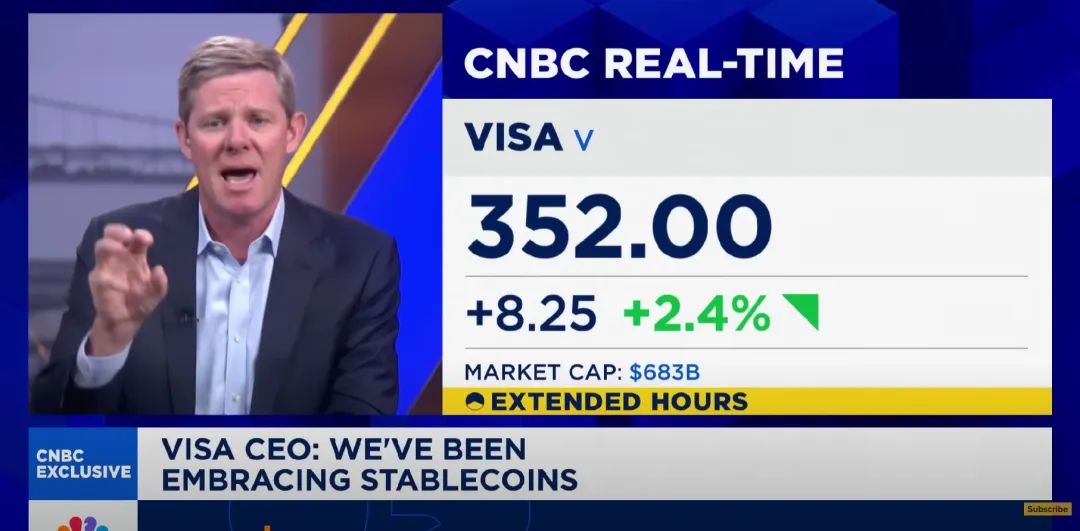
(Visa CEO on GENIUS ACT: We've been embracing stablecoins)
1. A "Potential" Important Moment in Payment History
Jack Forestell, Visa:
For Visa, the GENIUS Act should be seen as a "potential" important moment in the history of payments.
It is termed "potential" because, while stablecoins represent the opportunity to usher in the next age of digital programmable money, there is still much work to be done to achieve true scalability.
Visa CEO Ryan McInerney also stated, "Our world hasn't changed much with the passage of the stablecoin bill; Visa has been preparing for the arrival of the stablecoin world for years."
Expanding new payment technologies is not easy; it requires building extensive trust among buyers, sellers, payers, and payees. Establishing this trust takes time and is rooted in a series of complex and interwoven functions. Through the interplay of these functions, security, reliability, safety, fraud protection, dispute resolution, ease of use, and ongoing innovation can be achieved.
For stablecoins to become part of the next generation of digital payment infrastructure, they need to be grounded on three levels:
1. Technology Layer
There must be a robust, scalable, flexible, and open technological backbone capable of securely and reliably executing large-scale transactions with zero tolerance for failures, leaks, or violations.
Advancements in blockchain technology have provided promising solutions to this issue.
2. Reserve Layer
Trust must be established in the value and stability of the medium of exchange.
Regulated, reserve-backed stablecoins provide a solution to this problem.
3. Interface Layer
There must be a ubiquitous interface layer that participants actively want to engage with:
- This layer must provide trust, rules, standards, security, and value for both parties in each transaction.
- It must scale to cover billions of end participants.
- It must offer users a simple and convenient mechanism to convert value tokens into their chosen fiat currency (i.e., users must be able to use the value tokens they receive wherever they can and want to).
The stablecoin infrastructure itself cannot solve the issues of the final layer; without solutions, stablecoins will not achieve widespread adoption or realize the vision of becoming a mainstream medium of value exchange.
If they cannot be popularized, they will certainly be used to address narrow payment issues, provide closed-loop solutions, and serve as the underlying infrastructure for wholesale currency flow markets and capital markets, but will not scale in mainstream payments.
Web3 Xiaolu's Thoughts:
We can use the blockchain, validated over more than a decade, as the settlement layer, and compliant stablecoins as the reserve layer, thus forming a stablecoin infrastructure. Similarly, the On/Off Ramp networks and financial institutions for fiat currency channels around the world are equally important.
On this basis, we can achieve convenient exchanges between fiat and stablecoins to support numerous real-world scenarios for stablecoin payments, addressing the "last mile" issue and making stablecoins ubiquitous.
The strategic layouts observed here can be summarized simply as:
- Visa strategically invests in stablecoin infrastructure BVNK; BVNK subsequently connects with online/offline acquiring giant Worldpay and cross-border SME acquiring solution Lianlian Pay, while combining its own capabilities like Visa Direct and Account/Card products to achieve the last mile. Reference article: Web3 Payment Research Report: The Web3 Transformation of Consumer Cross-Border Payments.
- Circle issues its own stablecoin USDC, starting with a partnership with Coinbase, and then builds the Circle Payment Network with various global financial institutions—an important network for stablecoin infrastructure to achieve the last mile. Reference article: Circle Releases "Stablecoin Payment Network" White Paper.
- Stripe acquires Bridge and Privy to realize stablecoin infrastructure capabilities; through Stripe's B2B2C strategy, it empowers B-end platforms like Shopify to achieve the last mile. Reference article: Stripe Acquires Bridge, Stripe Acquires Privy.
- Ripple moves from the XRP blockchain to the RippleNet financial institution network and then to the RLUSD stablecoin. Reference article: Ripple, XRP, RippleNet.
- PayPal links its self-issued stablecoin PYUSD with its ecosystem, including superapp applications like PayPal and Venmo, to integrate its customer base and serve its 40 million users, allowing everyone to pay as they wish.
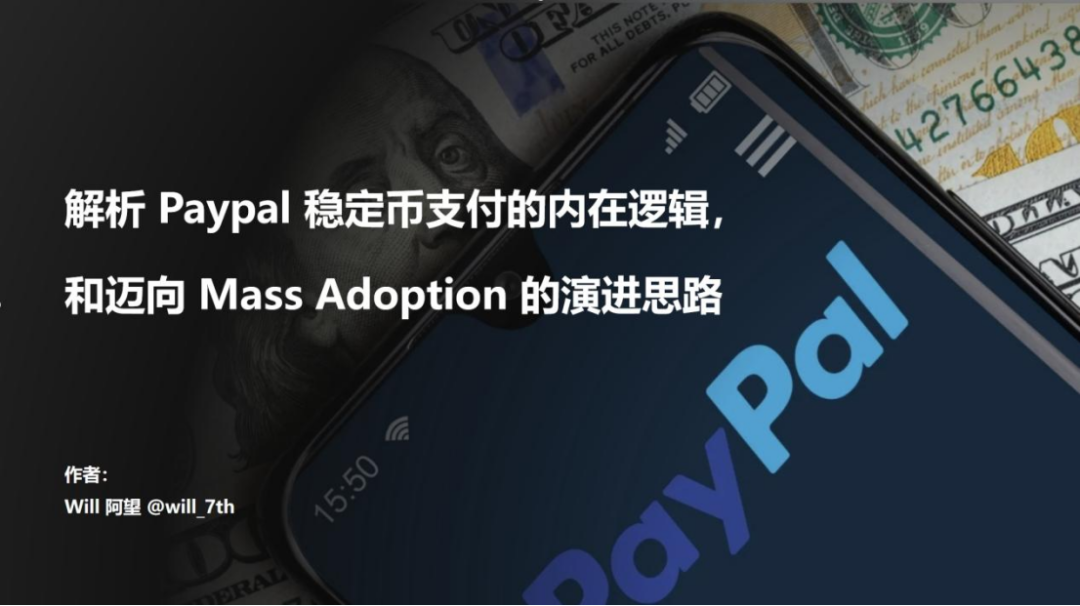
At the launch of PYUSD, PayPal introduced its evolution strategy:
From its inception, PayPal's responsibility was not only to facilitate payment implementation but also to introduce and disseminate a new technology—digital payments, which have now become ubiquitous in our lives.
Although PayPal's stablecoin PYUSD may not be as eye-catching, PayPal's previous successful experiences can provide guidance and novel insights for the launch of PYUSD stablecoin payments. Specifically, PayPal divides the evolution of Mass Adoption into three stages:
- Awareness; the GENIUS Act is the best awakening.
- Utility; clearly, we are currently in this stage.
- Ubiquity; more scenarios supporting stablecoin payments need to emerge, rather than just clustering to apply for stablecoin licenses.
Similarly, the Visa CEO mentioned in the interview the capabilities needed to truly realize payments, which complement PayPal's evolution strategy:
Expanding new payment technologies is not easy; we need:
- Trust (support from thousands of financial institutions on Visa)
- Ease of use (front-end payment products, such as Visa Card, etc.)
- Scalability (Visa's network of tens of millions of consumers and merchants)
The final stage of adopting any new payment technology is ubiquity, characterized by seamlessly integrating technology into daily life. At this stage, people can effortlessly use new payment technologies without awareness—they simply pay at will, just as we connect to the internet without worrying about the communication formats of the telecom operators behind it.
For users, this may have nothing to do with blockchain or stablecoins.
2. Visa Will Help Solve This Issue
Jack Forestell, Visa:
Visa has built the largest, most secure, most trusted, and most recognized third-layer payment system globally. Visa has invested billions of dollars in its continuous improvement, enhancing its compatibility with underlying transaction mediums and enabling all parties to easily and flexibly integrate into the Visa ecosystem.
By integrating Visa's infrastructure, services, and connections, Visa provides seamless, secure digital payment experiences for billions of buyers and sellers worldwide, with unparalleled scale, reliability, and security. Visa refers to this powerful combination as the "Visa as a Service" stack.
From the smallest sellers to the largest banks and enterprises, when the world needs to expand payment solutions, they choose the Visa stack. Cryptocurrency-native partners are no exception. For years, Visa has collaborated with leading cryptocurrency and stablecoin participants and platforms to provide access to the Visa stack and achieve the resulting massive payment scalability.
Since 2020, Visa has facilitated nearly $95 billion in cryptocurrency purchases and over $25 billion in cryptocurrency spending—totaling over $100 billion in capital flow.
Global consumers and businesses view 4.8 billion Visa credentials and nearly 14 billion Visa digital tokens as the best payment method and the best way for everyone, everywhere to receive payments. Visa's technology stack provides an excellent payment experience and will continue to invest to make it the most advanced, secure, and convenient payment method.
With Visa's capabilities, users no longer need to ask themselves the following questions before shopping:
- Will this merchant accept my payment?
- Do I need a dedicated wallet to make a payment?
- Do I have the correct type of currency in my wallet? Am I on the right blockchain?
- What is the Gas Fee for making this payment?
Can I maintain my privacy? Once I purchase something from a merchant, can others see all my transaction records and addresses without my permission?
- Can I get rewards?
- How do I use my credit?
- If I encounter a problem, who do I talk to?
- Is it safe?
The vast majority of consumers and businesses will continue to use fiat currency for payments and enjoy the convenience brought by Visa credentials. The same applies to stablecoin-driven solutions connected to the Visa stack.
Web3 Xiaolu's Thoughts:
The core point Visa wants to express here is that even if you have the capability of stablecoin infrastructure, having the capability alone is far from enough. We can help you achieve scalability—Scale—through the Visa ecosystem and Visa's capabilities. This is the core.
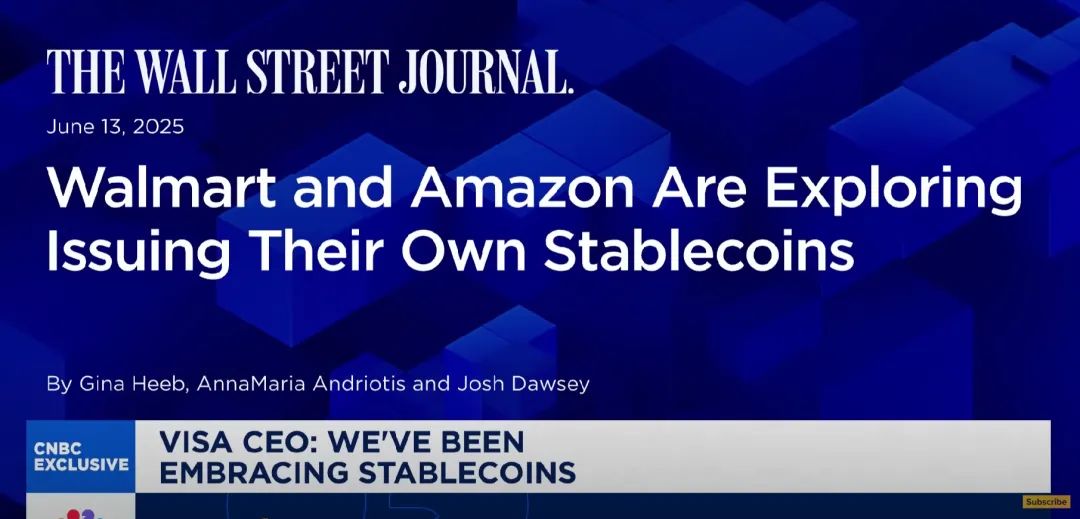
(Visa CEO on GENIUS ACT: We've been embracing stablecoins)
However, just like Walmart and Amazon, who have reported that they are also considering issuing their own stablecoins, if these companies with huge use cases can bypass the Visa/Mastercard settlement network, they could save a significant amount in payment intermediary fees, which would greatly enhance their profitability.
This is a question Visa cannot avoid.
As mentioned in the previous article "Web3 Payment Research Report: How Stablecoins Will Evolve in 2025":
The transaction fees of the current payment system directly erode the profits of most businesses, and reducing these fees will bring significant profit margins to companies. The first shoe has dropped: Stripe announced that they will charge a 1.5% fee for stablecoin payments, which is 30% lower than the fees they charge for credit card payments.
For convenience, this assessment assumes that businesses pay a 1.6% mixed payment transaction fee/cost, and the currency acceptance cost is extremely low.
- Walmart has an annual revenue of $648 billion and may pay $10 billion in credit card fees, with a profit of $15.5 billion. Calculate: eliminating payment fees could increase Walmart's profitability, and thus its valuation (not considering other factors) could increase by over 60% simply through cheaper payment solutions.
- Chipotle is a rapidly growing fast-food chain with an annual revenue of $9.8 billion. It has an annual profit of $1.2 billion, with credit card fees amounting to $148 million. By simply reducing payment fees, Chipotle's profitability could increase by 12%—an astonishing figure that cannot be obtained elsewhere on its balance sheet.
- National grocery chain Kroger has the lowest profit margins, thus profiting the most. Surprisingly, Kroger's net income and payment costs may be nearly equal. Like many grocery stores, its profit margin is below 2%, lower than the costs incurred by businesses processing credit card payments. With stablecoin payments, Kroger's profits could potentially double.
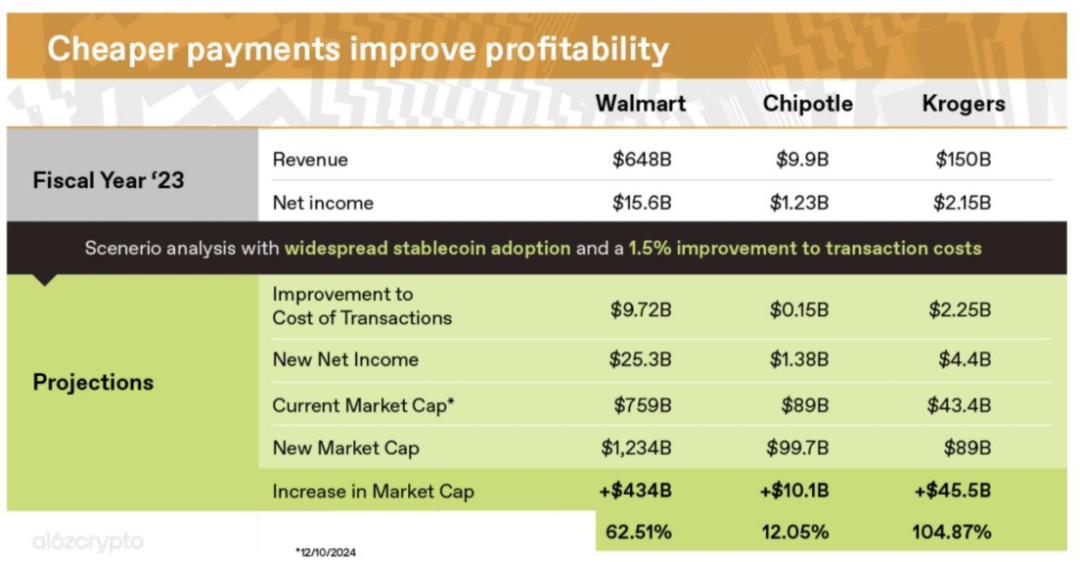
(How stablecoins will eat payments, and what happens next, a16z)
3. What Problems Can Stablecoins Solve?
Jack Forestell is often asked, "What problems do stablecoins actually solve?"
In response, he stated: First, stablecoins have perfectly found Product Market Fit in the cryptocurrency trading market, and for certain use cases, including emerging markets, stablecoins still represent significant opportunities. In particular:
- For users in small currencies, high inflation, and currency-restricted countries who wish to hold dollars but cannot easily access them.
- For certain cross-border capital flow use cases, such as C2C personal remittances or B2B inter-company payments.
Tether's CEO: Less than 40% of Tether's market cap is related to the cryptocurrency market. In other words, over 60% of the market cap growth actually comes from the grassroots use of USDT in emerging markets. The next driver of USDT's market cap growth may come from commodity trading.
Visa views these use cases as new processes that have not yet been fully addressed, providing pathways for Visa's business growth. In this regard, Visa plans to collaborate with stablecoin-native partners, platforms, and our financial institution partners to fully leverage the powerful capabilities of the Visa stack.
Currently, it is unclear whether consumers and businesses in developed markets like the U.S. are willing to use stablecoins for payments, as there are already many competitive options available to make payments directly from bank accounts using "digital dollars."
The GENIUS Act has brought practical regulatory clarity to stablecoins, opening potential pathways for further applications. Visa has actively developed various solutions in the stablecoin space, including:
- Deploying Visa credentials and Visa digital tokens to connect stablecoins and cryptocurrency platforms and their users with fiat currency and our global network.
- Providing local stablecoin settlement.
- Implementing cross-border capital flow solutions through stablecoin infrastructure.
- Offering programmable currency solutions to clients.
- And more solutions are in development.
Of course, it will take time for stablecoins to truly become genius— and we are just getting started.
Web3 Xiaolu's Thoughts:
Visa's CEO clearly stated that there is a misunderstanding among the public regarding stablecoins: because currently, they are all dollar stablecoins, people naturally assume that the U.S. is the primary landing area for stablecoin applications. However, the real use case Product Market Fit for stablecoins is actually in regions outside the U.S., specifically in what we call the Global South—Asia, Africa, and Latin America. There are about 30-50 countries where the integration of stablecoins can significantly enhance financial efficiency.
Tether's CEO previously confirmed this in an interview with Bankless:
The U.S. is one of the markets with the highest efficiency in capital flow globally, with financial channel efficiency reaching 90%. The introduction of stablecoins could potentially increase that efficiency from 90% to 95%, with very limited premium space. In contrast, in other parts of the world, the introduction of stablecoins could provide a 30%-40% increase in financial efficiency. Therefore, for these countries, the significance of stablecoins is even greater.
Thus, in these markets, even for Visa, it is difficult to reach. In our previous article (Web3 Payment Research Report: The Web3 Transformation of Consumer Cross-Border Payments), we observed that payment method choices vary across different countries. Those interested can take a closer look.
- Germany: Consumers are the least willing to use credit or debit cards (only 32%), preferring digital app payment services (49%) and bank transfers or wire transfers (35%). This may be because consumers place more importance on the security and ease of payment, as emphasized in the "2022 Western Europe Online Payment Methods" report.
- Philippines: Consumers prefer digital app payment methods (49%), which may be related to the fact that 48.2% of consumers cannot access traditional banking systems.
Similarly, we can see in Worldpay's 2025 report that the penetration rate of Visa/Mastercard in Nigeria, a major economy in Africa, is very low. Cash remains king offline.
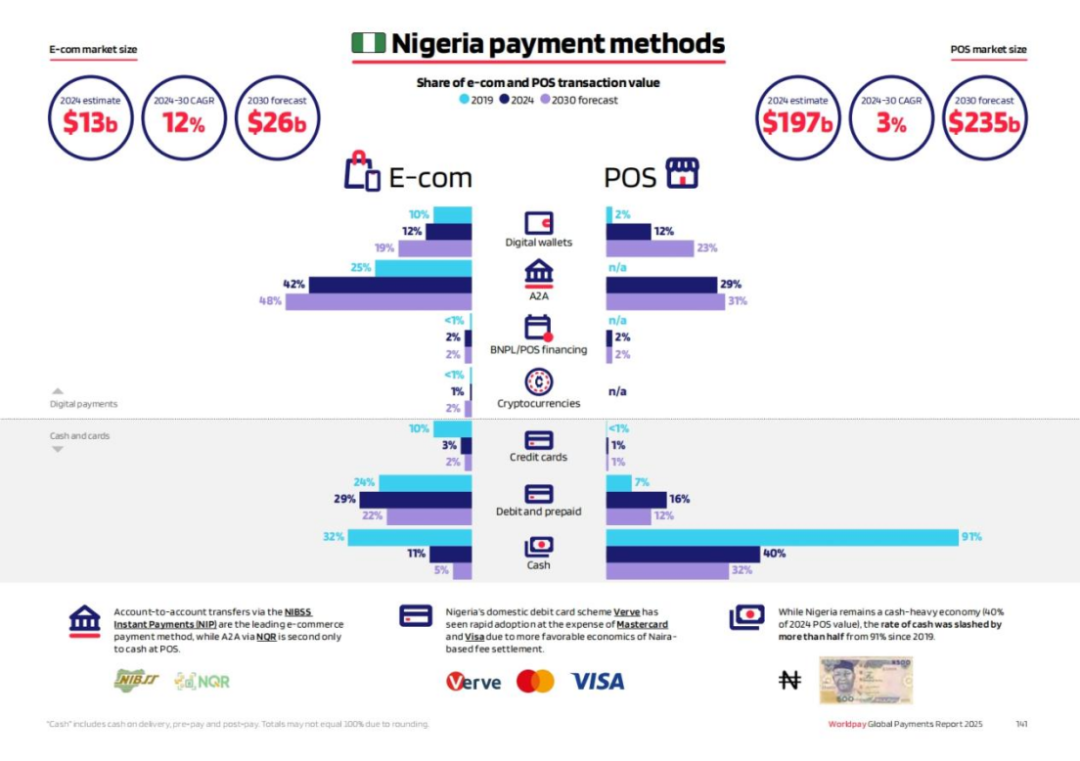
(GPR 2025: the past, present and future of payments, WorldPay)
This is the strength of Tether. While the Global North is engaged in an arms race, Tether has already penetrated the Global South.
- With 3 billion people still unbanked globally, Tether currently covers 450 million users, presenting a huge opportunity where distinguishing between different stablecoin products and application scenarios is crucial.
- Deepening into Asia, Africa, and Latin America, investing in infrastructure, and innovating distribution channels and deep penetration into emerging markets are key to Tether's leading position in the stablecoin space. Tether is not only technologically advanced but has also established an unprecedented dollar distribution network globally, which is one of Tether's least known advantages.
If Circle's listing has turned its back on competitors from traditional finance and industry giants,
Then Tether's competitors come from the "Belt and Road" of the East. :)
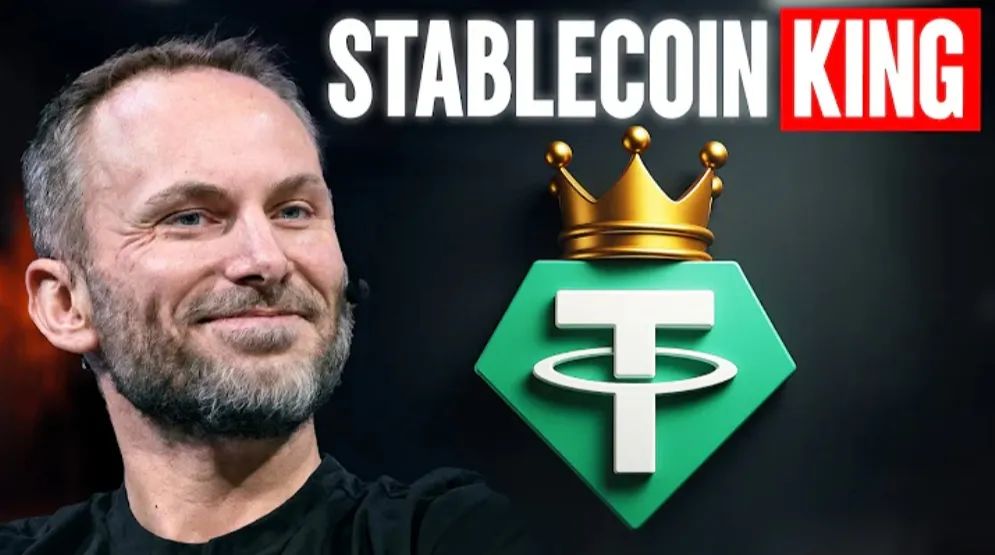
(Tether CEO's understanding of the next phase of stablecoins)
免责声明:本文章仅代表作者个人观点,不代表本平台的立场和观点。本文章仅供信息分享,不构成对任何人的任何投资建议。用户与作者之间的任何争议,与本平台无关。如网页中刊载的文章或图片涉及侵权,请提供相关的权利证明和身份证明发送邮件到support@aicoin.com,本平台相关工作人员将会进行核查。




